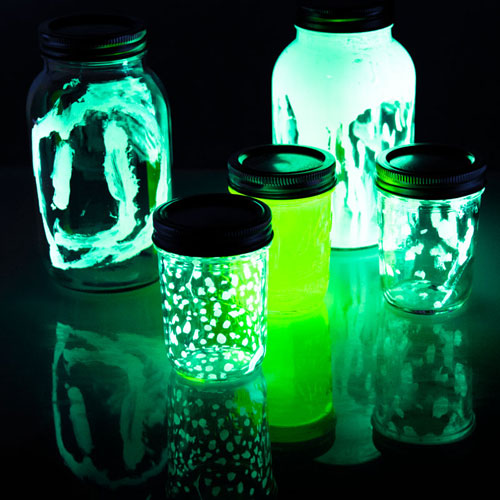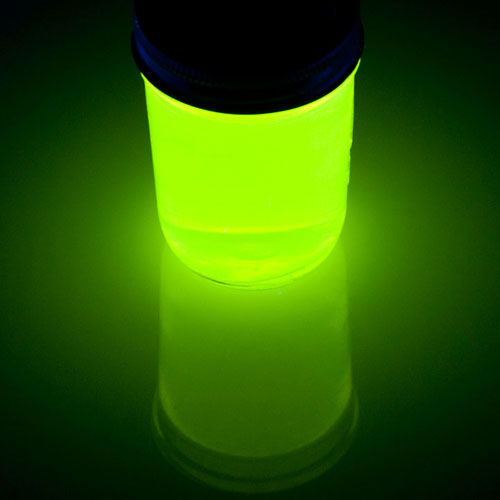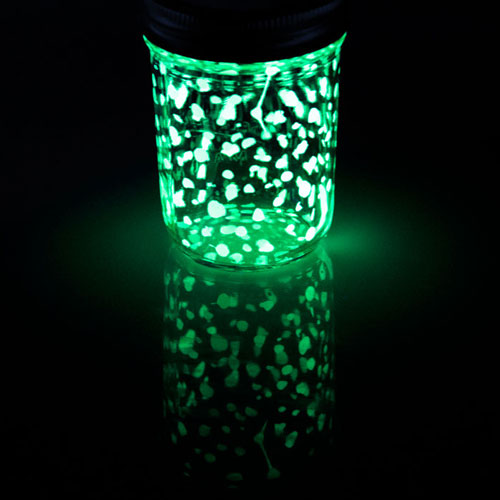Sick Science! Summer Camp – Make Your Own Firefly Glow Jars & Glowing Drinks
By Blog Editor: Susan Wells
In Denver, our dry heat keeps many bugs from living amongst us. Usually, this isn’t such a bad thing. We don’t miss the chiggers, the cockroaches, or other bugs found in other parts of the United States.
We do miss the fireflies.
I always enjoyed visiting my cousins who lived in the midwest and catching fireflies on warm summer nights. Since we can’t do that in Denver, and I don’t feel like driving to Kansas City, the girls and I made firefly jars.
This is an easy activity that I have seen on Pinterest.
Most people cut open glow sticks and empty them into a Mason jar. There are two problems with this – the liquid only glows for a short time and glow sticks contain glass which breaks to release and mix the chemicals.
You can make firefly jars that glow over and over again. All you need is a few Mason jars, paint brushes, glue and Zinc Sulfide Glow Powder or Atomic Glow Concentrate.
Science of Glow
Before you get started, you must understand the difference between the Zinc Sulfide Glow Powder and Atomic Glow Concentrate, or the terms fluorescence and phosphorescence.
It’s also important to note that not all zinc sulfide glows, but luminous zinc sulfide does glow!
Fluorescence – This type of luminescence occurs when some form of radiation, such as light, causes an object to glow. For example, fluorescent papers and poster boards glow in the daylight. They glow even brighter under black light (ultraviolet light). Ultraviolet light is a component in sunlight. Ultraviolet wavelengths are very long with a very high frequency and can be used to detect fluorescent material that would remain invisible under normal conditions. When you shine ultraviolet light on fluorescent material, it lights up with a beautiful bluish-green luminescence.
In either case, as soon as the light is removed, the glow stops. Fluorescent things do not glow in the dark all by themselves – they require some other form of energy such as ultraviolet light to “excite” them.
Under normal light, Atomic Glow will turn water a cool greenish-yellow color. Under a black light, the goo actually glows an eerie green color. Atomic Glow is fluorescent and needs a black light to make it glow.
Parents – also note that Atomic Glow will stain.
Phosphorescence – Phosphorescence is just like fluorescence, except that the glow continues even after the light used to excite it is removed. “Glow in the dark” toys phosphoresce brightly in total darkness after being “charged” or excited by ordinary white or ultraviolet light. Glow Powder contains zinc sulfide and works by absorbing surrounding light energy and then releases that energy when the lights go out. You can charge the zinc sulfide with white light or ultraviolet light from a black light.
Make Firefly Glowing Jars
First decide if you want to make fluorescent or phosphorescent glowing jars. Remember, phosphorescent jars do not need a black light to charge the particles, but will need to be recharged often.
- Wash Mason jars.
- Mix Elmer’s glue with a few drops of Atomic Glow (fluorescent) or a few scoops of Glow Powder (phosphorescent).
- You can also fill the jar with tap water and then add a few drops of Atomic Glow then turn off the lights and turn on the black light. You will have a jar filled with glowing goo.
- Using a paint brush or cotton swab, paint in the jar.
- You can also let it drip and swirl in the jar.
- Let dry.
- Charge in white light (phosphorescent) or place under black light (fluorescent).
Glowing Summer Drinks and Ice Cubes
You can make cool glowing party drinks for your backyard bar-be-que using tonic water.Tonic water contains quinine, a chemical that glows under a black light. Quinine was added to tonic water to help fight off malaria. Tonic water still contains a small amount of quinine, which makes it a perfect material for glowing drinks. Add a little Tonic water to your drinks, then place a black light behind them. The drinks will glow in the night. Just keep in mind that darker drinks, like Cola won’t glow as well as clear drinks like Sprite.
You can also make glowing ice cubes. Pour tonic water into an ice cube tray and freeze. Add the ice cubes to your drinks and place a black light under or behind them.
For step by step instructions and more on the science of glow, visit our Fireflies in a Jar experiment page.







i always watch your show i think your the best guy with sience ever because you do it in a fun way can you please send me your latest vidios and the corn starch experiment is so fun so far i have almost 30 boxes
As a crafter I was recently informed by someone of the glow in the dark jars. I thought how cool how do you do that. When she told me she actually cut glow sticks I was shocked, first it’s kinda toxic plus I thought about the glass. So I asked why didn’t you just buy glow in the dark paint? it was as if clouds cleared from her hazy mind. I think a lot of time people complicate things when it’s actually much simpler.
Thanks so much! I saw the glow stick idea floating around the internet and thought “there has to be a better way than breaking open toxic glow sticks”. And voila! You had the solution! I have a few ideas of my own I’m going to implement with this, so like I said, thanks! ^_^
Your welcome Jenny! We have been concerned about all of the projects that involve breaking open glow sticks that are circulating the Internet. There is definitely a better and safer way.
I would really like to order some Glow Powder to make the Mason jar lamps for a science camp, but I have no idea how much to order! How many grams do you think would be needed to make 100 jars? Thanks!
Hi Diane – The glow powder will go a long way if you mix it with Elmer’s glue or something similar. For 100, I’d suggest a 227g Glow Powder Jar https://www.stevespanglerscience.com/glow-powder-with-mini-black-light.html or 1 bottle of Atomic Glow should stretch that far too. You just need a few drops in a jar of water to make it glow. https://www.stevespanglerscience.com/atomic-glow-concentrate.html